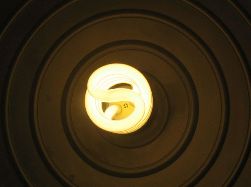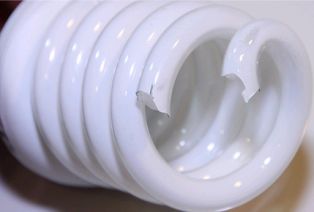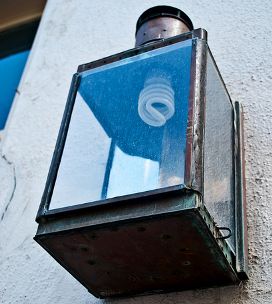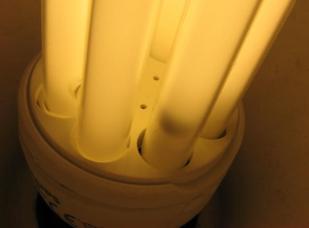Categories: Sharing experience, Sources of light
Number of views: 25063
Comments on the article: 6
Extend the life of a compact fluorescent lamp (housekeeper)
 Compact fluorescent lamps are increasingly used every year to illuminate both residential and industrial buildings and structures. Initially, the use of so-called housekeepers was due to the saving of consumed electric energy. Really, compact fluorescent lamp consumes 4-5 times less electrical energy compared to a conventional incandescent lamp. But are they saving money?
Compact fluorescent lamps are increasingly used every year to illuminate both residential and industrial buildings and structures. Initially, the use of so-called housekeepers was due to the saving of consumed electric energy. Really, compact fluorescent lamp consumes 4-5 times less electrical energy compared to a conventional incandescent lamp. But are they saving money?
Many will answer negatively, since the experience of using fluorescent lamps in everyday life indicates that there is no saving in the family budget. In this case, the fact is that the housekeepers fail, and not having fulfilled the term of work declared by the manufacturer, and accordingly its cost does not pay off by the amount of electricity saved. But, in any case, if it is correct to operate compact fluorescent lamps, they will serve the declared term. In this article, we give practical recommendations that will help extend the life of a compact fluorescent lamp.
The main reason why housekeepers fail is their misuse. As a rule, few people know the features of the operation of lamps of this type and, when the lamp fails, they sin on the manufacturers. Consider the basic rules for the operation of housekeepers, as well as the consequences for lamps that arise as a result of their non-compliance.
Firstly, one should take into account the fact that an energy-saving lamp cannot be screwed (twisted), while holding on to a glass bulb (spiral). Neglect of this rule leads to the fact that the housekeeper fails. In this case, there is a high probability that a glass bulb can burst at the place of attachment to the body - the lamp explodes literally in the hands. After this incident, few will want to deal with housekeepers.
But in this case, there are exceptions - some types of lighting devices do not allow you to install a lamp, holding on to the body. In this case, there is no other way out, how to screw the lamp, holding on to the bulb. Therefore, it is necessary to do this as carefully as possible, preferably with gloves, since with possible destruction of the flask you can be injured by glass fragments.

If it is necessary to use lamps in rooms characterized by high humidity, use lamps with an appropriate degree of protection IP. If the fluorescent lamp is not protected from moisture, then after some time it will lead to failure of the elements of the electrical circuit due to corrosion.
Recently gained wide popularity dimmers. Compact fluorescent lamps, as a rule, are designed to operate at specified nominal parameters of the electric network, therefore, the use of dimmers reduces the lamp life significantly. This is due to the fact that when adjusting the brightness of the cross section, the voltage that is supplied to the lamp is much less than the nominal.
It should also be noted that fluorescent lamps are characterized by a high starting current. Therefore, to power the luminaires, it is necessary to use switches that can withstand the inrush current that occurs when the luminaire is turned on.
In some cases, when it is necessary to turn on several lamps, it is recommended to install several light switches. Otherwise, the inrush current when the lamps are turned on can cause the contacts of the switch to burn.

The energy-saving lamp has permissible operating temperatures, which are indicated in the passport (on the package).Failure to comply with this condition, that is, the operation of lamps in conditions of high or low temperature, leads to a significant reduction in the life of the lamps.
A very important point is the method of installing the lamp and the design features of the lamp. If the lamp is placed upside down, then during its operation there is an excessive overheating of the lamp electronic unit. This is due to the fact that the heat generated from the luminous bulb, according to the laws of physics, rises up, which leads to excessive heating of the lamp housing in which the electronic unit is located.

The design of the lamp, providing for the installation of lamps with the base down, is most acceptable for housekeepers. In this case, most of the heat coming from the bulb goes up. Therefore, when the lamps are placed with the base down, damage to the electronic unit of the lamps due to overheating occurs much less frequently.
But in some types of fixtures, the entire lamp heats up, including the electronic unit, regardless of its position. An example is the fixtures of a protected type, in which the lamp is completely closed by a ceiling. In this case, the heat generated from the bulb of the lamp heats the entire interior space inside the lampshade, which leads to excessive overheating of all the lamp elements.
You should also take into account the fact that the declared lamp life is the lamp life during continuous operation. In this case, the smaller the on and off operations, the longer the lamp will last. Accordingly, if the lamp is turned on ten to fifteen times a day, as is usually the case in everyday life, then its service life will be significantly reduced. This is due to the fact that the structural elements of the lamp, in particular the elements of the electronic unit, operate in an abnormal mode when the lamp is turned on.
By observing the above rules, you can significantly extend the life of compact fluorescent lamps. But there are times when the cause of burnout is completely different. As mentioned above, the lamp will work the declared period in case of compliance with all operating conditions. One of the conditions is the nominal parameters of the electrical network, in particular the voltage.
Increased or vice versa low voltage, as well as surges lead to a significant reduction in lamp life.
It is possible to solve the problem of frequent failure of lamps due to poor-quality power supply (power surges, over or under voltage, overvoltage) voltage stabilizer.
Very often, a voltage stabilizer is installed at the entrance of the apartment. That is, in this case, all household electrical appliances of the apartment, including lighting devices, are connected through a voltage regulator. This, ultimately, leads to the fact that the voltage regulator fails due to systematic overloads.
On the one hand, the installation of a stabilizer at the input is justified by the fact that in addition to lighting, many household electrical appliances are used, which should also work within the permissible parameters of the electric network. This is, first of all, computer equipment, audio and video equipment, televisions and more. But for such electrical appliances as a heater, an electric furnace, a water heater, slight deviations of voltage from the nominal value are not so critical. In addition, these household electrical appliances account for most of the load on the apartment. It turns out the following picture.
For example, the total power consumption of all used household electrical appliances in an apartment is 8 kW. The power of those electrical appliances for which a stabilizer was installed, including lighting devices, was 1 kW. It turns out that installing a stabilizer for all household electrical appliances is illogical.It is most advisable to install a voltage stabilizer on the wiring lines that feed the lighting of the rooms of the apartment and those electrical appliances for which it is also necessary to stabilize the voltage.
In addition to the above, mention should be made of such a reason for the failure of compact fluorescent lamps, such as defective products. That is, a lamp that initially has some "flaws" can fail even if all the rules for operating lamps of this type are observed.
In order to avoid such a problem, it is recommended to purchase those lamps that are covered by the warranty period. As a rule, the warranty period of housekeepers is one year. That is, if during the year the lamp fails, then it will be replaced.
See also at bgv.electricianexp.com
:

